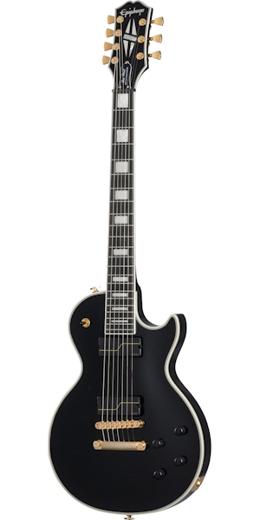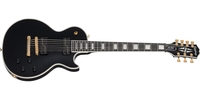Epiphone Matt Heafy Les Paul Custom Origins 7-String vs Ibanez JIVA10
Reasons to Get
Epiphone Matt Heafy Les Paul Custom Origins 7-String over Ibanez JIVA10
Reasons to Get
Ibanez JIVA10 over Epiphone Matt Heafy Les Paul Custom Origins 7-String
Other Key Differences
Epiphone Matt Heafy Les Paul Custom Origins 7-String vs Ibanez JIVA10
Shared Features
Epiphone Matt Heafy Les Paul Custom Origins 7-String vs Ibanez JIVA10
Common Strengths
- High-Quality Nut
- Top Pickup Brand
- Expensive Wood
Common Weaknesses
- Stays in Tune (Evertune)
- High-Quality Frets
- Compound Radius Fretboard
- 21:1 Tuner Ratio
- Active/Passive Preamp
Table of Contents
Price History Comparison
These are affiliate links. We may earn a fee if you purchase after clicking. These prices are prone to error. Make sure you're buying the right product after clicking on a link from our site. We are not liable if you buy the wrong product after following these links. As an Amazon Associate site we earn from qualifying purchases.
Which One is Better Overall?
After going through our comparison algorithm, the results show that both instruments scored 71 out of 100, which makes them similar in terms of quality.
The Ibanez JIVA10 wins when it comes to sound, playability. On the other hand, the Epiphone Matt Heafy Les Paul Custom Origins 7-String has the upper hand when it comes to build quality.
If you got small hands, you'll probably feel more comfortable playing the Ibanez JIVA10.
Which One is Better for Beginners?
If you're looking for your first guitar to learn how to play, the Epiphone Matt Heafy Les Paul Custom Origins 7-String is the better choice.
The Epiphone Matt Heafy Les Paul Custom Origins 7-String meets 5 out of our 8 criteria items for beginner friendliness, while the Ibanez JIVA10 meets only 3. This takes into account the type of frets, scale length, nut width, bridge type, fretboard radius, and neck profile to determine the easiest combination for new players.
New Player Friendliness
Epiphone Matt Heafy Les Paul Custom Origins 7-String- Comfortable shape
- Easy-to-use bridge
- Locking tuners
- Tall frets
- Comfortable neck
- Comfortable fretboard
- Narrow nut
- Short scale
New Player Friendliness
Ibanez JIVA10- Comfortable shape
- Tall frets
- Comfortable neck
- Comfortable fretboard
- Narrow nut
- Short scale
- Locking tuners
- Easy-to-use bridge
Nevertheless, when it comes to choosing an instrument, you should pick the one more compatible with your personal style. Still, below we'll try you to give you our results as objectively as it's possible to help you decide.
Epiphone Matt Heafy Les Paul Custom Origins 7-String Overview
- From Epiphone's 2022 Artist Collection series
- Matt Heafy Signature
- Made in China
- 7 strings
- 25.5"'' scale
- 12" Fretboard Radius
- Mahogany body
- Mahogany neck
- Ebony fretboard
- Bridge pickup: Fishman MKH Fluence Ceramic (Humbucker/Passive)
- Neck pickup: Fishman MKH Fluence Alnico (Humbucker/Passive)
- 2 volume and 2 tone Dome knobs
- 3-way Switch
- Epiphone LockTone Tune-O-Matic bridge
- SpeedTaper D Set neck
- 22 Medium Jumbo frets
- Grover Locking Mini Rotomatic with Tulip Buttons tuners
- Compare Specs >
Ibanez JIVA10 Overview
- From Ibanez's 2020 JIVA series
- Nita Strauss Signature
- Made in Indonesia
- 6 strings
- 25.5"'' scale
- 16" Fretboard Radius
- Quilted Maple top
- African Mahogany body
- 3pc Maple/Purpleheart neck
- Bound Ebony fretboard
- Bridge pickup: DiMarzio Pandemonium (Humbucker/Passive)
- Middle pickup: DiMarzio True Velvet (Single Coil/Passive)
- Neck pickup: DiMarzio Pandemonium (Humbucker/Passive)
- 1 volume and 1 tone Dome knobs
- 5-way Switch
- Edge-Zero II tremolo bridge
- Wizard III Bolt-On neck
- 24 Jumbo frets
- Ibanez tuners
- Compare Specs >
Sound Quality Comparison
The wood used in an electric guitar or bass is not as important to determine the final tone. However, some people prefer specific wood types, so we'll take a look at those first. Then, we'll take a look at the electronics to determine the versatility and sound quality of each instrument.
Woods Used in Both


Mahogany is a fairly rare wood nowadays. It's used mostly for bodies due to its relatively lightweight. Gibson popularized it with their Les Paul guitars during their golden years, so this wood has a lot of good reputation behind it. The most expensive type comes from South America and it's still used by Gibson even today. Find out more about Mahogany.
Ebony is a high-end wood, so it is not cheap. It's only used for fretboards because it's also very heavy. It does an excellent job as a durable material while looking elegant. Find out more about Ebony.
Woods Used in the Ibanez JIVA10

Maple is one of the most popular necks for good reasons. It is a strong wood that is relatively cheap to make and looks beautiful. The highest quality maple is the hardest that comes from North America. Find out more about Maple.
Winner: Tie.
Pickup Configuration
The Epiphone Matt Heafy Les Paul Custom Origins 7-String has an HH configuration while the Ibanez JIVA10 has HSH pickups.
Double Humbucker (HH) is the choice for people who want a fuller, more round sound with tons of mids and lows. Humbuckers also get rid of the hum noise that plague single-coil pickups. They can work out for almost any genre going from Djent to even Jazz.
On the other hand, HSH is a versatile pickup configuration that will give you the high output, full tone, and quiet sound of humbucker pickups, but with the possibility of using a single coil for cleaner tones. The disadvantage is that the middle single-coil pickup will have a noticeable lower volume, so you might want to adjust the height of the pickups. Another problem is that if you set the middle pickup too high, it might interfere with your picking hand.
Pickups Quality
Both come with very good pickups from at least one of the specialized brands in the market. With pickups like these, you probably won't need an upgrade anytime soon.
However, the Epiphone Matt Heafy Les Paul Custom Origins 7-String has a slight sound quality advantage when taking into account other factors like the type of pickups, magnet, position, etc.
We found the same or similar pickups to the Ibanez JIVA10's online:
Both use Passive pickups. This is what's used for most music genres. They have a regular output and will serve you for both high-gain and clean tones. The alternative (Active pickups) offer a higher output that is mostly used for heavy music.
Winner: Epiphone Matt Heafy Les Paul Custom Origins 7-String.
Versatility Comparison
Some instruments offer you more ways to explore your creativity than others. Below you'll find how both compare when it comes to versatility.
Switch Options
The Ibanez JIVA10 gives you 5 switch options while the Epiphone Matt Heafy Les Paul Custom Origins 7-String gives you 3. This means that the Ibanez JIVA10 gives you more options to find the right pickup combination for the type of sound you want to achieve
Only the Epiphone Matt Heafy Les Paul Custom Origins 7-String comes with some kind of pickup modification: Coil Split, Multi-Voicing.
Coil Split lets you disconnect one of the pickup coils. When used with humbuckers, it turns them into single-coil with lower output and cleaner tone.
Multi-Voicing means the pickups come with multiple ''voices'', which means they can change the tone and gain by a simple switch or knob. Piezo, Fishman and similar are considered multi-voicing pickups.

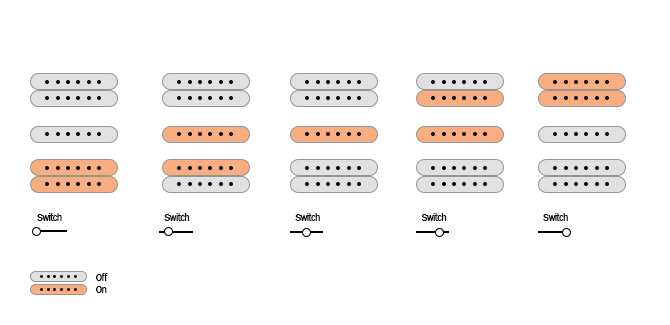
When evaluating versatility, we also take into consideration bridge and neck joint type, number of frets, switch options, amount of pickups and more.
Winner: Ibanez JIVA10.
Final Sound Quality Scores
Build Quality Comparison
When it comes to build quality, we like to take into account everything used to build the instrument. This includes materials, hardware and the quality control expected depending on the country where it was built. Let's see how the Epiphone Matt Heafy Les Paul Custom Origins 7-String compares to the Ibanez JIVA10.
Country of Origin
The manufacturing country can tell a lot about the build quality of an instrument. The Epiphone Matt Heafy Les Paul Custom Origins 7-String is built in China while the Ibanez JIVA10 is made in Indonesia.
China has a bad reputation when it comes to building quality. However, times have changed and now respectable brands use China's cheap labor to build good instruments for a lower price. Don't discount a guitar only because it was built in China, but also expect more quality from countries like Korea.
Indonesia is becoming the most popular country for guitar building because they can make good instruments for a low price. Some people think that they're 'the new China' when it comes to build quality. But the truth is that Indonesian guitars are more consistent, although Chinese quality has improved a lot in the last few years.
Winner: Ibanez JIVA10
Nut Material
If you want your guitar to stay in tune and sound good, you need a well cut nut. Nut quality can be inconsistent even when comparing two copies of the same model. The best way to make sure you're nut will be well done is by getting a nut made by an expert company like TUSQ or Micarta.
The Epiphone Matt Heafy Les Paul Custom Origins 7-String has a Ivory Tusq nut. Ivory used to be considered the best material for guitar nuts due to its beauty, durability, and the rich harmonics and sustain you could get from a guitar with it. However, the way to obtain it is simply unethical. Enter TUSQ ivory nuts, which are made synthetically to imitate ivory. Technically, it's better than ivory because it is consistent piece-to-piece, while natural materials can vary a lot, even if they're made from the same.
On the other hand, the Ibanez JIVA10 comes with a Locking nut. Instead of a regular nut, this guitar has a locking system that will lock down the strings at the nut, preventing it from getting out of tune. It removes one of the disadvantages of tremolo bridges, tune stability.
Winner: Tie.
Fret Material
Most fret wire is made of nickel silver. This material eventually wears down after a lot of use and most instruments end up needing a complete fret replacement. However, some expensive models come with stainless steel frets. This is what you should aim for if you can afford it.
Unfortunately, none of them come with stainless steel frets.
Winner: Tie.
Bridge
The perfect bridge for you will depend on your playstyle because they all have advantages and disadvantages. However, some bridges are more expensive—like Floyd Roses and Evertunes—and thus add more value to a guitar.
The Epiphone Matt Heafy Les Paul Custom Origins 7-String's brige is a Fixed. It's a simple bridge that is very beginner-friendly since it doesn't require any set-up. You can swap strings easily. It might also give more sustain since it doesn't have complex moving parts that make the strings lose vibration. However, it doesn't have the same versatility as a tremolo bridge.
On the other hand, the Ibanez JIVA10's is a Edge Zero II. This is a cheaper version of Ibanez's Edge Zero bridges. It comes with the same locking stud bolts that lock down into the body and provide better stabilization, and with easier adjustment of the springs without having to remove the backplate thanks to a thumb-screw. However, the intonation in this cheaper version will require additional work.
Edge Zero IIs that come with the ZPS3 Zero Point system have two extra springs that help return the tremolo to the neutral position faster. These bridges offer tons of versatility, but they also require more work than simpler tremolos to set up.
Since we need to be objective, the most expensive type of bridge will be the winner of this section. In the end, this doesn't matter if you're not going to use the bridge for its original purpose, so choose the bridge that fits your playing style better.
Winner: Ibanez JIVA10.
Tuners
The Epiphone Matt Heafy Les Paul Custom Origins 7-String has the best tuners of the two because they are locking tuners. They'll help to keep your guitar in tune because they allow you to tune it without wrapping the strings around the posts. This avoids variations in the tuning due to the strings changing position at the post after a bend. They come at the disadvantage of being slightly heavier than regular tuners. Also, it makes it a lot easier to restring.
Nevertheless, the Ibanez JIVA10 has a locking nut, so it should have even better tune stability and doesn't need locking tuners.
Winner: Epiphone Matt Heafy Les Paul Custom Origins 7-String.
Neck Joint
Contrary to popular belief, the difference in sustain and tone that some neck joints give to a guitar is simply unperceivable—if they're all well built. However, some of them do have advantages over the others.
The Epiphone Matt Heafy Les Paul Custom Origins 7-String has a Set neck joint. This neck is tightly glued to the body. They give you the least versatility because you can't swap them for a neck that fits your hand better if you want to, unlike bolt-on necks. Some people think this gives more resonance and sustain, but there's no real difference if the bolt-on joint is well built.
On the other hand, the Ibanez JIVA10 comes with Bolt-On neck joint. This neck is joined to the body by 4 bolts that you can simply unscrew. This allows you to replace the neck or take it off for travel. It's the most common and cheapest way to build a guitar.
Winner: Ibanez JIVA10.
Here is the list of features that were considered when choosing the winner in the Features subcategory:
Epiphone Matt Heafy Les Paul Custom Origins 7-String
- Locking Tuners
- Expensive Wood
- Ivory Tusq Nut
- Top Brand Pickups
- Coil Split, Multi-Voicing Pickups
- Weight Relief
- Strap Lock
- Cheap Fret Wire (NS)
- Made in China
- No Neck-Through Build
- No Luminescent Inlay
- No Tremolo
- No Compound Radius Fretboard
- No 21:1 Tuner Ratio
Ibanez JIVA10
- Expensive Wood
- Locking Nut
- Top Brand Pickups
- Luminescent Inlay
- Tremolo
- Cheap Fret Wire (NS)
- No Locking Tuners
- Made in Indonesia
- No Neck-Through Build
- No Push Knob or Extra Switch Option
- No Weight Relief
- No Compound Radius Fretboard
- No 21:1 Tuner Ratio
- No Retainer Bar
- No Strap Lock
Final Build Quality Scores
Playability Comparison
Let's now compare their playability. Bear in mind that the instrument will feel different depending on your hand size and play style. That's why you should always test before buying. But if you can't or want a second opinion on it, we can still take a look at each of the important measurements of the instrument for you. This way, we can predict how easy a guitar might be to play, or how different it will feel compared to the other.
Remember that, even though the difference might seem small, every inch counts when it comes to feeling of the instrument in your hands. Any variation can completely change how comfortable a guitar feels in your hands.
Nut Width
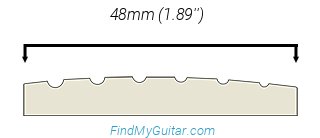

The nut width will affect the separation between strings at the nut. In this comparison, the Epiphone Matt Heafy Les Paul Custom Origins 7-String has the wider nut with 48mm (1.89'') vs 43mm (1.693''). This is a 5mm (0.197'') difference
This means that it will be more difficult to do bar chords on the Epiphone Matt Heafy Les Paul Custom Origins 7-String, especially closer to the nut. However, it's also easier to play without muting strings accidently. This favors people with big hands.
Scale Length

The scale length is one of the things that influences playability the most. This is the distance between the nut and the bridge and will affect everything from low action allowance, difficulty to perform bends, fret separation, and even tone.
In this case, both have a scale length of 25.5".
This is the scale used in most Stratocasters. It's slightly longer than the typical 24.75'' size found in Les Pauls, and it's one of the main reasons why Stratocasters have such a bright sound in general. A longer scale also means that the strings will have higher tension. This will help you get lower action without suffering fret buzz, which will also be helpful when playing in lower tunings without having to increase your string gauge.
However, this also means that there will be more separation between frets, which can make it more difficult to play. Also, bending the strings will require more strengths due to the increased tension, but remember that a tremolo guitar will offset this difficulty.
Lastly, remember that you can also affect the tension of the strings by changing your string gauge. You can use a thicker gauge for more tension and a lighter one for less tension.
Neck Profile
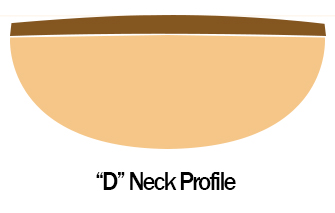

No single neck shape is better than others. However, most people tend to prefer a thinner necks because it doesn't get in their way when playing fast and most hand sizes can adapt to it pretty well. However, some people still prefer thicker necks for a better grip, especially if they have big hands.
In this case, both have different neck shapes:
The Epiphone Matt Heafy Les Paul Custom Origins 7-String has a D type of neck. This is a thin and flat neck that is made for playing fast. If you prefer a neck that doesn't get in your way when soloing, this is the shape you should use. Guitarists that prefer to have a bit more grip won't like this type of neck.
The Ibanez JIVA10, on the other hand, has a Wizard neck. This is thinner than most C-type necks. It won't get in your way if you want to play fast solos. It's not as slim as 'Super Wizard' necks, so it might fit you better if you don't like ultra-thin necks.
Fretboard Radius


Most guitar fretboards are not flat; they usually have a curve or arc across their width. A curved fretboard will make it easier to perform chords without muting strings, while a flatter one will make it easier to play single notes, which is good for bending and soloing in general. The best fretboards have a compound radius that varies across the fingerboard, but they're not common since they take a lot more work to build.
In this case, the Epiphone Matt Heafy Les Paul Custom Origins 7-String's fingerboard radius is smaller, which means it's more curved than the Ibanez JIVA10's. This extra arc will make playing chords easier in this model. You won't be as likely to mute the strings, especially if you have big hands. However, playing single notes and bending will be easier on the Ibanez JIVA10.
Still, both tend to favor soloing over chords, so if you're looking for a guitar for playing rhythm, you might want something else with a radius closer to a Stratocaster's 9.5''.
Hand Size Comfortability
Everyone has a different hand size, and that's why it's recommended to try a guitar before buying, even if others tell you that it's comfortable to play. However, we can know whether a guitar favors small or large hands just by knowing its exact measurements.
And after taking into account the scale length, nut width, neck profile and fretboard radius, we can conclude that the Epiphone Matt Heafy Les Paul Custom Origins 7-String favors large hands more than the Ibanez JIVA10.
Epiphone Matt Heafy Les Paul Custom Origins 7-String:
Ibanez JIVA10:
Fret Size


The Ibanez JIVA10 has Jumbo frets, which should be taller than the Epiphone Matt Heafy Les Paul Custom Origins 7-String's Medium Jumbo frets.
Some people prefer taller frets because they result in more sustain since the strings get pressed cleanly without interference from the fretboard. However, if they're too tall—like Jumbo frets—, you might change the pitch of the strings accidentally if you press too hard because you won't be touching the fretboard with your fingers. This is also why some guitarists with a heavy grip prefer smaller frets. They like to feel the fingerboard to avoid pressing down too hard and getting out of pitch.





